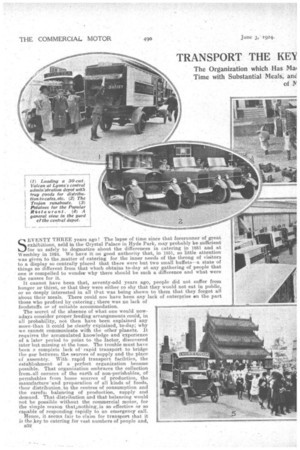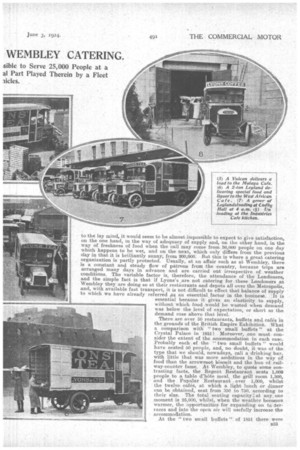TRANSPORT THE KEY WEMBLEY CATERING.
Page 16

Page 17

Page 18

Page 19

If you've noticed an error in this article please click here to report it so we can fix it.
The Organization which Has Ma■ Time with Substantial Meals, anC of N sible to Serve 25,000 People at a at Part Played Therein by a Fleet
SEVENTY THREE years ago! The lapse of time since that forerunner of great exhibitions neld in the Crystal Palace in Hyde Park, may probably be sufficient for us safely to dogmatize about the differences in catering in 1851 and at Wembley in 1924. We have it on good authority that, in 1851, so little attention was given to the ,matter of catering for the inner needs of the throng of visitors to a display so centrally placed that there were but two small buffets--a state of things so different from that which obtains to-day at any gathering of people that one is compelled to wonder why there should be such a difference and what were the causes for it.
It cannot have been that, seventy-odd years ago, people did not suffer from hunger or thirst, or that they were either El o shy that they would not eat in public, or so deeply interested in all that was being shown to them that they forgot all about their meals. There could not have been any lack of enterprise on the part those who profited by catering; there was no lack of
foodstuffs or of suitable accommodation.
The secret of the absence of what one would nowadays consider proper feeding arrangements could, in all probability, not then have been explained any more-than it could be clearly explained, to-day; why we cannot communicate with the other planets. It requires the accumulated knowledge and 'experience of a later period to point to the factor, discovered later but missing at the time. The trouble must have been a complete lack of rapid transport to bridge the ear between the seurces of supply and the place of assernbly. WAIL rapid transport facilities, the establishment of a perfect organization became possible. That organization embraces the collection from. all corners of the earth of non-perishables, of perishables from home sources of production, the manufacture'and preparation of all kinds of foods, their distribution,to the centres of consumption and the careful balancing of production, supply and demand. That distribution and that balancing would not be possible -without the commercial motor, for the simple reason thatoothing,is so effective or so capable of responding rapidly to an emergency call.
Hence, it seems fair to claim for transport that it is the key to catering for vast numbers of people and, B32 to the lay mind, it would seem to be almost impossible to expect to give satisfaction, on the one hand, in the way of adequacy of supply and, on the other hand, in the way of freshness of food when the call may come from 50,000 people on one day which happens to be wet, and on the next, which only differs from the previous tib,y in that it is brilliantly sunny, from 200,000. But this is where a great catering organization is partly protected. Usually, at an affair such as at Wembley, there is a constant and steady flow of patrons from the country, because trips are arranged many days in advance and are carried out irrespective of weather conditions. The variable factor is, therefore, the attendance of the Londoners, and the simple fact is that if Lyons's are not catering for these Londoners at Wembley they are doing so at their restaurants and depots all over the Metropolis, and, with available fast transport, it is not difficult to effect that balance of supply to which we have already referred 0.8 an essential factor in the business. It is essential because it gives an elasticity to supply, without which fOod would be wasted when demand was below the level of expectation, or short as the demand rose above that level.
There are over 50 restaurants, buffets and cafés in the grounds of the British Empire Exhibition. What a comparison with "two small buffets" at the Crystal Palace in 18511 Moreover, one must consider the extent of the accommodation in each case. Probably each of the "two small buffets" would have seated 50 people, and, no doubt, it was of the type that we should, nowadays, call a drinking bar, with little that was more ambitious in the way of food than the arrowroot biscuit and the bun of railway-counter fame. At Wembley, to quote some contrasting facts, the Regent Restaurant seats 1,600 people to a table d'hôte meal the grill room 1,300, and the Popular Restaurant , over 1,000, whilst the twelve cafés, at which a light lunch or dinner can be obtained, seat from 350 to 750. according to their size. The total seating capacity; at any, one moment is 25,000, whilst, when the weather becomes warmer, the opportunities for expanding on tG -.terraces and into the open air will usefully increase the accommodation.
At the "two small buffets " of 1851 there were B33_ _
probably a dozen or so attendants. At Wembley there is a. staff" of 7,000 employed in the catering department. And what a wonderful contrasting picture one could draw with the food itself as the subject! The service at .t, h e Lucullus Restaurant, for example, is claimed to be the equal of that of any restaurant in Europe, Whilst, at the special cafes attached to the exhibits of India, West Africa, Malay, Australia and so f or t Ii, the products of those countries in the way of food and wines are obtainable.
A week's requirements include 75 tons of meat, 260 tons of bread and cakes, 40 tons of potatoes, 6 tons of tea and thousands of cases of tinned fruits, fish and other comestibles, whilst so much milk is required that a special railway siding for dealing with it has had to be laid down! Every hour 20,000 gallons of 'water are Yequired and over _100,000 cubic feet of gas is consumed to keep the )1Tens going! Those figures equal the consumption )f any one of England's large towns!
However, figures of this kind convey very little to the reader who is, since 1918, accustomed to speak and think in -millions, but here is a much more impressive fact, for it brings into view an ideal which is only attainable with the assistance of fast transport. The impressive fact towhich we draw atten
tion is that the time allowed between bakery and shop counter or restaurant for bread rolls is half an hour I Consider another factor in the case, that Lyons's shops are scattered all over London and it is possible to realize the strides made since 1851, when half a day would have been the interval between the cook and the customer !
Of Lyons's 50 restaurants and cafes at Wembley 13 are equipped with their own kitchens and, therefore, receive' from Cadby Hall raw materials which are prepared for consumption on the spot. The Regent Restaurant, as an example, has half an acre of kitchen space. The remainder of the cafes and buffets draw their supplies on standard trays—in other words, receive them ready for the customer.
Each restaurant, cafe or buffet is treated as a separate shop. It is given a distinguishing letter, its manager nightly indents on Cadby Hall for the next day's Supplies, these indents are .scanned at headquarters and amended in the light of any fuller inforniation.that H.Q. may possess, and the requirements are then brought together during the night on the standard trays, the distinguishing letter of the restaurant, cafe or buffet being marked thereon.
By 'blur o'clock in the morning these trays with their loads are ready for transport. Seventeen 2-ton Leyland lorries, each capable of carrying 72 trays, and 13 1i-ton Vulcans, each with 48 trays, are loaded up and by 5.30 a.m. are all on their way to Wembley. Here the food trays and raw materials are unloaded at the restaurants and cafés, the balance going to the administration building of the company. After the Leylands are unloaded they return to Cadby Hall for the second delivery about mid-day. The Vulcans return unloaded to the administration building and, 'with a Trojan van, transfer to the different cafes all the goods that have been received there, being engaged on this occupation the whole of the day. All empties are cleared to the central administration and, in the evening, they are taken to Cadby Hall by vehicles returning thereto. Sometimes the Leylands have to do six journeys a day, at others, three journeys suffice. Trojan cars are used by the staff going from place to place in the grounds—for the place is too vast for walking. So far, there has not been any unexpected rush of visitors. But if there were a sudden ,emergency, Lyons have a fleet of 600 petrol-driven vehicles' so that reserves are ample. As an instance of what can be done, there was a call to H.Q. the other day for '3,000 cut portions of meat for the players attending a band rehearsal and at one hour's notice ! The men sat down to their meal prompt to the moment !
It is quite interesting to observe the vehicles al work and to note the expedition of the transfer, the attention to cleanliness and the care generally that is taken by the staff. A glance at the kitchens shows that the same spirit of cleanliness and care permeate every phase of the handling of food, which is as it should be.






























